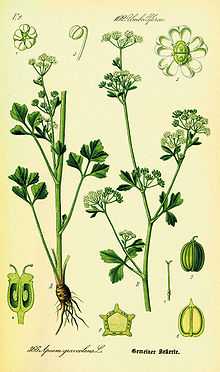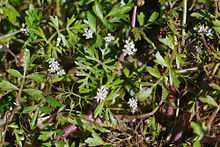Apium
| Apium | |
|---|---|
 | |
| Apium graveolens | |
| Scientific classification | |
| Kingdom: | Plantae |
| (unranked): | Angiosperms |
| (unranked): | Eudicots |
| (unranked): | Asterids |
| Order: | Apiales |
| Family: | Apiaceae |
| Genus: | Apium L. |
| Species | |
|
See text | |
Apium (including celery and the marshworts) is a genus of about 20 species of flowering plants in the family Apiaceae, with a subcosmopolitan distribution in Europe, Asia, Africa, South America and Australia. They are medium to tall biennial or perennial plants growing wet ground (marshes and salt marshes). They grow up to 1 m high and have pinnate to bipinnate leaves and small white flowers in compound umbels. Some species are edible, notably Apium graveolens, which includes the commercially important vegetables celery, celeriac and Chinese celery. Apium bermejoi from the island of Minorca is one of the rarest plants in Europe, with fewer than 100 individuals left.[1]
The genus is the type genus of the family Apiaceae and the order Apiales.
Species include:
- Apium annuum P.S.Short[2]
- Apium australe
- Apium bermejoi
- Apium fernandezianum - Johow.
- Apium filiforme
- Apium graveolens L. - Celery, Wild Celery[3]
- Apium inundatum - lesser marshwort
- Apium insulare P.S.Short[4] - Flinder's Island celery
- Apium leptophyllum - marsh parsley, or fir-leafed celery
- Apium nodiflorum - Fool's water cress
- Apium prostratum Vent. - Sea Celery[5]
- Apium repens - creeping marshwort
Apium species, including garden celery, are eaten by the larvae of some Lepidoptera species including Angle Shades, Common Swift, Hypercompe icasia, The Nutmeg, Setaceous Hebrew Character and Turnip Moth.

References
- ↑ IUCN Redlist: Apium bermejo.
- ↑ "''Apium annuum". FloraBase. Department of Environment and Conservation, Government of Western Australia.
- ↑ "Apium graveolens". FloraBase. Department of Environment and Conservation, Government of Western Australia.
- ↑ "Apium insulare". Australian Plant Name Index (APNI), IBIS database. Centre for Plant Biodiversity Research, Australian Government, Canberra. Retrieved 2009-10-05.
- ↑ "Apium prostratum". FloraBase. Department of Environment and Conservation, Government of Western Australia.